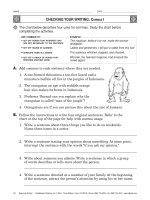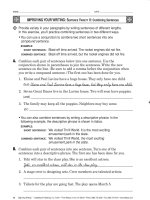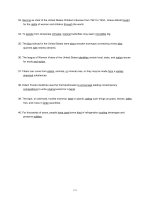Tài liệu Beginning writing 1 part 7 doc
Bạn đang xem bản rút gọn của tài liệu. Xem và tải ngay bản đầy đủ của tài liệu tại đây (156.56 KB, 10 trang )
48
Beginning Writing 1
• Saddleback Publishing, Inc. © 2001 • Three Watson, Irvine, CA 92618 • Phone: (888) 735-2225 • Fax: (888) 734-4010 • www.sdlback.com
NAME DATE
PREWRITIN
G
/
I
DEAS AND CONTENT: W
RITING
TO
I
NFORM
A paragraph that
informs
shares information with the reader. A paragraph
about the childhood of a famous person, for example, would be informative.
A.
Remember to limit your topic so you can present
specific details. Circle the topic in each pair that would
be most appropriate for an informative paragraph.
1. fads of the 1920s / the Roaring Twenties
2. King Tut / mummies
3. diseases / chicken pox
4. the solar system / meteorites
5. nutrition / Vitamin C
One good way to begin an informative paragraph is with a clear definition.
EXAMPLES:
Vincent Van Gogh was a Dutch painter known for his use of bold, vivid color.
The garter snake is the most common harmless snake in the United States.
B.
Write definition statements for five of the topics in the box. Make sure
that each definition could serve as a topic sentence for an informative
paragraph. (Use a dictionary or encyclopedia if you need help with facts.)
the sea lion the common cold the northern lights palm trees
fly-fishing the First Amendment the human heart the snail
comets
Romeo and Juliet
the artichoke Santa Claus
Central Park the Mississippi River Charlie Chaplin Paul Bunyan
1. ____________________________________________________________________
2. ____________________________________________________________________
3. ____________________________________________________________________
4. ____________________________________________________________________
5. ____________________________________________________________________
CHALLENGE: Choose one of the definition statements you wrote in Part B.
On the back of this sheet, write three details you would use to develop
the definition as a topic sentence.
Saddleback Publishing, Inc. © 2001 • Three Watson, Irvine, CA 92618 • Phone: (888) 735-2225 • Fax: (888) 734-4010 • www.sdlback.com •
Beginning Writing 1
49
NAME DATE
my bus stop
1. What do you see?
2. What do you hear?
3. What do you smell?
4. What might you touch?
5. What is one small detail that
is special about the place?
PREWRITING
/
IDEAS AND CONTENT: WRITING TO DESCRIBE
A
descriptive paragraph
needs specific details to create a picture in the reader’s
mind. Like other types of paragraphs, a descriptive paragraph must have a topic
sentence and supporting details.
A.
Each topic listed below is too general. Narrow it down to a topic suitable
for one paragraph. Ask yourself: Could I create a clear picture for my
reader in four or five sentences? The first one has been done for you.
1. my town ➞ _____________________ 4. the ocean ➞ __________________
2. Italian food ➞ __________________ 5. spring ➞ _____________________
3. my house ➞ ____________________ 6. trees ➞ ______________________
Clear description creates not only a visual
picture, but a complete image. You can help
your reader understand your experience by
using more than one sense to describe.
B.
Each word below appeals to one of the
following senses. Complete the chart by
writing each word in the correct category.
sour beeping sparkling frigid fragrant handsome
slimy slender delicious silent sweltering earsplitting
SIGHT HEARING TASTE SMELL TOUCH
C.
Add two descriptive words of your own to each category in Part B.
CHALLENGE: Think of a place that you really like or especially dislike. Picture
yourself there. On the back of this sheet, answer these questions:
50
Beginning Writing 1
• Saddleback Publishing, Inc. © 2001 • Three Watson, Irvine, CA 92618 • Phone: (888) 735-2225 • Fax: (888) 734-4010 • www.sdlback.com
NAME DATE
PREWRITING
/
IDEAS AND CONTENT: WRITING TO INSTRUCT (HOW TO)
Some paragraphs instruct readers how to do something. A how-to paragraph should:
1. State the process in a topic sentence.
2. Describe any materials needed.
3. Present the steps in chronological
order—the order of time.
A.
Read the following how-to paragraph. Then answer the questions below.
Spice up your chips with homemade salsa dip. Make a quick trip to
the grocery store to get tomatoes, an onion, green chiles, cilantro, fresh
lemons, and salt. First, chop the vegetables into small pieces. (Before
chopping the chiles, you might put on rubber gloves. Hot chile juice can
burn. Also, don’t touch your eyes when handling peppers, and carefully
wash your hands afterward.) After chopping the vegetables, mix them
well. Then add salt and lemon juice to taste. Don’t be in a hurry to eat!
The salsa will taste better if it sits for at least 30 minutes. Let those
flavors blend! Finally, serve the salsa with tortilla chips.
1. What process is the writer explaining? ________________________________
___________________________________________________________________
2. What ingredients are needed to make salsa?___________________________
___________________________________________________________________
3. What is the first step in preparing salsa? _____________________________
___________________________________________________________________
4. What is the final step the writer describes? ___________________________
___________________________________________________________________
5. Do you think you could make salsa after reading these instructions?
Why or why not? ___________________________________________________
___________________________________________________________________
B.
You can help your reader follow your instructions by using certain words.
Some of these words are before, first, after, next, then, and finally. Reread the
paragraph in Part A. Circle words that help readers follow the order of the steps.
CHALLENGE: Think of a simple activity you do well (serving a tennis ball,
teaching your dog a trick, repairing a bike tire). On the back of this sheet,
write a topic sentence for a how-to paragraph. Develop the paragraph by
listing the materials needed and explaining the steps in chronological order.
Use at least two clue words that will help your reader follow the steps.
Saddleback Publishing, Inc. © 2001 • Three Watson, Irvine, CA 92618 • Phone: (888) 735-2225 • Fax: (888) 734-4010 • www.sdlback.com •
Beginning Writing 1
51
NAME DATE
PREWRITING
/
IDEAS AND CONTENT: PERSONAL INTERESTS
What kinds of things do you do well or find interesting? Your
personal interests are good subjects for writing. What are your
favorite things to do, read about, or think about? Your personal
likes and dislikes can be used to spark topic ideas.
A.
Explore your own interests by completing the following statements.
1. I think I could teach a class in _______________________________________.
2. If I were in a waiting room, I would
most likely pick up a magazine about ________________________________.
3. If I were in a library, I would most likely go to the _____________________
section.
4. When I have a spare hour or two, I like to ____________________________.
5. If I could take a class in any subject, it would be ______________________.
6. If I could live in any historical period, it would be _____________________.
7. When I’m with my friends, we often talk about _______________________.
8. If I won a trip anywhere in the world, I’d go to ________________________.
B.
Write three of your statements below. Then come up with a list of writing
topics that relate to your interest.
EXAMPLES:
______________________________________________________________________________________
TOPICS: ________________________________________________________________________________
1. ____________________________________________________________________
TOPICS: _______________________________________________________________
_______________________________________________________________
2. ____________________________________________________________________
TOPICS: _______________________________________________________________
_______________________________________________________________
3. ____________________________________________________________________
TOPICS: _______________________________________________________________
_______________________________________________________________
When I have a spare hour or two, I like to go shopping.
teen fashions, styles of the ’80s, money-saving tips, weird fads
52
Beginning Writing 1
• Saddleback Publishing, Inc. © 2001 • Three Watson, Irvine, CA 92618 • Phone: (888) 735-2225 • Fax: (888) 734-4010 • www.sdlback.com
NAME DATE
PREWRITING
/
IDEAS AND CONTENT: PERSONAL EXPERIENCES
What am I going to write about? As writers begin to work, that’s the big
question they ask. Many subjects can be found in your own experiences.
Explore your memories—both good and bad. This exercise can help you
generate a personal collection of writing topics.
Complete each web diagram by listing examples from your own life.
1.
2.
3.
CHALLENGE: Use one idea from above as the topic of a narrative paragraph.
Imagine that someone has asked you, “What happened?” On the back of
this sheet, write a paragraph that answers that.
HUMOROUS MOMENTS
THE BEST DAYS
THE WORST DAYS
Saddleback Publishing, Inc. © 2001 • Three Watson, Irvine, CA 92618 • Phone: (888) 735-2225 • Fax: (888) 734-4010 • www.sdlback.com •
Beginning Writing 1
53
NAME DATE
PREWRITING
/
IDEAS AND CONTENT: BRAINSTORMING
Try looking at things in a different way! Let your mind
wander from thought to thought until you’ve created
a “storm” of ideas. You can brainstorm alone or in a
group. The following exercise works well with a partner.
Focus on some object in your home or classroom
that you’ve never before looked at carefully. View
the object from far away. Walk closer to it. Touch it.
Examine it from all angles. If appropriate, smell it.
Then answer the following questions.
1. What is the object? __________________________________________________
2. Which senses can you use to experience it? ____________________________
3. What is the object’s practical purpose? ________________________________
____________________________________________________________________
4. In what other way(s) might it be used? _______________________________
____________________________________________________________________
5. Who would be likely to use it? ________________________________________
____________________________________________________________________
6. What do you think it would say if it could talk? “_______________________
___________________________________________________________________”
7. What tiny detail do you notice about the object that most people would
miss? ______________________________________________________________
____________________________________________________________________
8. How would life be different if this object did not exist? _________________
____________________________________________________________________
CHALLENGE: Use the object and the ideas it sparked to write a paragraph.
You might tell a story, persuade your readers to buy something, compare
and contrast two things, or create an image. Write your paragraph on
the back of this sheet.
54
Beginning Writing 1
• Saddleback Publishing, Inc. © 2001 • Three Watson, Irvine, CA 92618 • Phone: (888) 735-2225 • Fax: (888) 734-4010 • www.sdlback.com
NAME DATE
PREWRITING
/
IDEAS AND CONTENT: TONE (FORMAL OR INFORMAL?)
Before you write, think about both your
purpose
and your
audience
.
This will help you judge how formal the tone of your writing should be.
A.
Decide what tone best suits each of the following types of writing.
Next to each item below, write F for formal or I for informal.
1. _____ letter requesting a job
interview
2. _____ letter to a pal who has
moved away
3. _____ party invitation to a
picnic and hayride
4. _____ research paper for
history class
5. _____ welcoming speech to a
new second-grade class
6. _____ advertisement selling
life insurance
B.
Read each of the following items and decide whether the writer’s tone is
formal or informal. Again, write F for formal or I for informal.
1. _____ The yapping pup had not had a lick of training.
2. _____ The defiant canine is lacking basic obedience training.
3. _____ I regret to inform you that you must vacate the premises.
4. _____ Sorry! You’re out of here!
CHALLENGE: Write formal or informal after each item. Then, on the back of
this sheet, rewrite the item so that it has the opposite tone.
2.
Dear valued friend,
Ms. Margo C. McGuire and I would sincerely appreciate
your presence at a summer barbecue on the evening
of July the 14th, in the year 2000. Festivities begin
promptly at 8 o’clock P.M. and will continue until guests
feel compelled to depart. Ms. McGuire and I look
forward to sharing the evening with you. Please
respond promptly with your acceptance or regrets.
Sincerely,
Ms. Janine D. Lomax
____________________
1.
Hi there!
Summer’s just around the corner,
and I wondered if you’re hunting for
new camp counselors. I’m a whiz with
kids and a super swimmer and hiker.
Dudes, you wouldn’t be sorry if you
put me on the payroll! Don’t let me
down, now. I’ll be waiting!
Take it easy!
Sam Sibone
____________________
Saddleback Publishing, Inc. © 2001 • Three Watson, Irvine, CA 92618 • Phone: (888) 735-2225 • Fax: (888) 734-4010 • www.sdlback.com •
Beginning Writing 1
55
NAME DATE
PREWRITING
/
IDEAS AND CONTENT: DECIDING ON POINT OF VIEW
Before writing, you have to decide how you will present your message.
Through whose eyes will the reader view the details? Most often, you
will write from one of the following
points of view
:
1.
First-person point of view
uses pronouns like
I, me, my, we,
and
our.
The first-person point of view is a personal account in which the narrator
takes part.
EXAMPLE: In
my
opinion,
our
school is best in the state.
I
am proud
to be a Portsmouth Penguin!
2.
Third-person point of view
uses pronouns like
they, he, she,
and
their
.
The narrator is not a part of the writing but tells about the subject.
EXAMPLE: Students at Portsmouth say
their
school is number one.
They
are proud to be Penguins!
Tell whether each sentence is written from the
first-person point of view or third-person point
of view. Write 1st or 3rd on the line.
1. _____ As I looked into the barber shop mirror,
I knew I could not face my friends!
2. _____ The Japanese samurai faced death bravely
because they were highly trained warriors.
3. _____ One autumn night I found out why the
owl is said to be wise.
4. _____ We survived the car crash, but it changed
my life forever.
CHALLENGE: On the back of this sheet, rewrite this paragraph from a
different point of view.
I love the new Greek restaurant on 54th Street. Last weekend I ate there
for the first time, and I especially enjoyed the lemon-flavored chicken soup.
A garlicky spread turned my plain piece of bread into something special.
Gobs of sweet honey made my dessert a sticky treat. When I returned
there this weekend, I found a line of people waiting for a table. It seems
I’m not the only diner who has fallen in love with Dimitri’s.
56
Beginning Writing 1
• Saddleback Publishing, Inc. © 2001 • Three Watson, Irvine, CA 92618 • Phone: (888) 735-2225 • Fax: (888) 734-4010 • www.sdlback.com
NAME DATE
PREWRITING
/
IDEAS AND CONTENT: DECIDING ON VERB TENSE
As a writer, you must decide what
verb tense
to use
in a piece of writing. You may write in the
past tense
.
I decided to phone Sarah. My fingers twitched
nervously as I punched the buttons.
Or you may write in the
present tense
.
I decide to phone Sarah. My fingers twitch
nervously as I punch the buttons.
Important hint:
Whichever tense you choose, stick to it!
Avoid shifting tenses throughout the written piece.
A.
Rewrite each sentence so that the tenses of the boldface verbs match.
1. The golfer makes her shot and then followed the ball with her eyes.
___________________________________________________________________
2. The champ entered the ring, goes to his corner, and nodded to the crowd.
___________________________________________________________________
3. Chico whistled for his dog Ranger, and Ranger bounds to his side.
___________________________________________________________________
4. Everywhere Chico goes, Ranger followed him. _______________________
___________________________________________________________________
B.
Decide whether you will write each item below in the past tense or present
tense. Then complete each sentence by adding verbs of that tense. The first
one has been done for you.
1. ___________ The snow _______ silently and soon ___________ the ground
with white.
2. ___________ The fans ____________________ into the stadium and
____________________ to their seats.
3. ___________ Dinosaurs ____________________ huge creatures that
____________________ the earth ages ago.
CHALLENGE: On the back of this sheet, write a paragraph about an exciting day.
Make sure you stick to the same verb tense from beginning to end!
present falls
blankets
Saddleback Publishing, Inc. © 2001 • Three Watson, Irvine, CA 92618 • Phone: (888) 735-2225 • Fax: (888) 734-4010 • www.sdlback.com •
Beginning Writing 1
57
NAME DATE
LAUGH OUT LOUD! MISPLACED AND DANGLING MODIFIERS
Misplaced modifiers and dangling modifiers can make a mess of
meaning! Sometimes speakers and writers send a very different
message from the one they intended to send. These silly errors—
sometimes called bloopers—can make people laugh out loud! Read
each blooper below. Then rewrite it to convey its intended meaning.
1. Sports announcer at a San Diego Padres baseball game:
Winfield goes back to the wall. He hits his head on the wall
and it rolls off! Now it’s rolling toward second base!
____________________________________________________________________
____________________________________________________________________
2. Line written on an accident report:
The cause of the accident was a guy in a small car with a big mouth!
____________________________________________________________________
____________________________________________________________________
3. In the classified ads:
For sale: large dining room set perfect for big family made of solid oak.
____________________________________________________________________
____________________________________________________________________
4. Anther ad:
Holiday bazaar—hundreds of gifts for the hard-to-find person.
____________________________________________________________________
5. Sign in a pet store: We will sell goldfish to anyone in a glass bowl.
____________________________________________________________________
6. Road sign: Drive slower when wet.
__________________________________________________
__________________________________________________
7. Sign in a clothing store: Huge pants sale!
__________________________________________________
__________________________________________________









